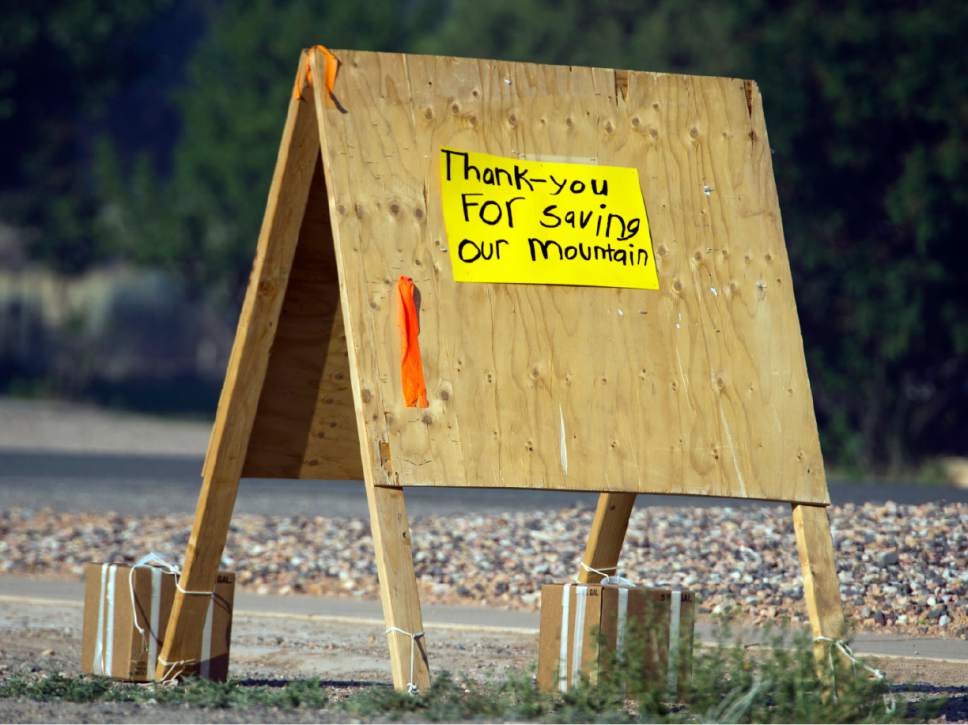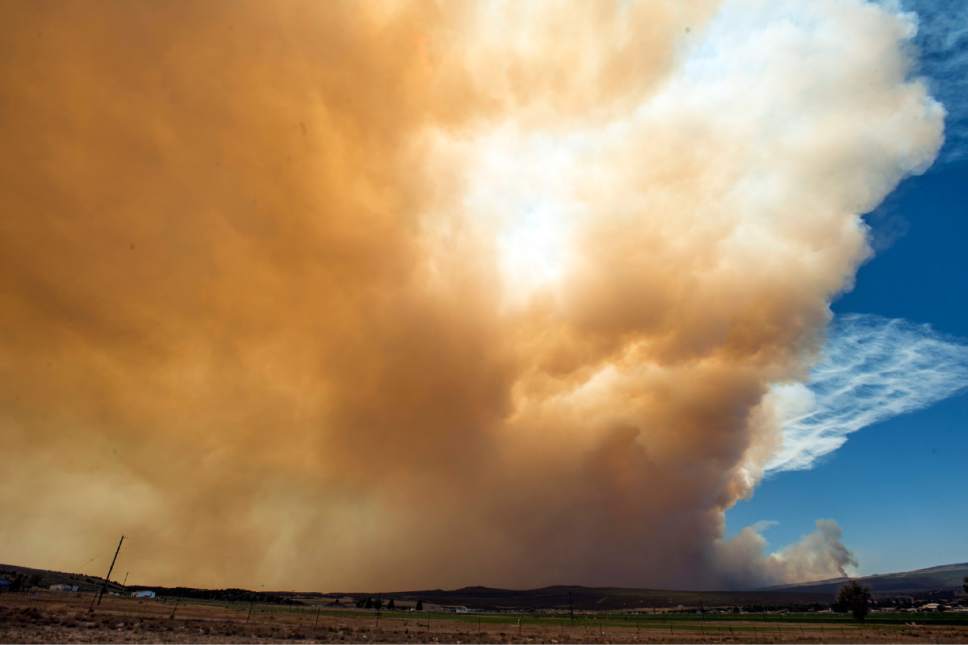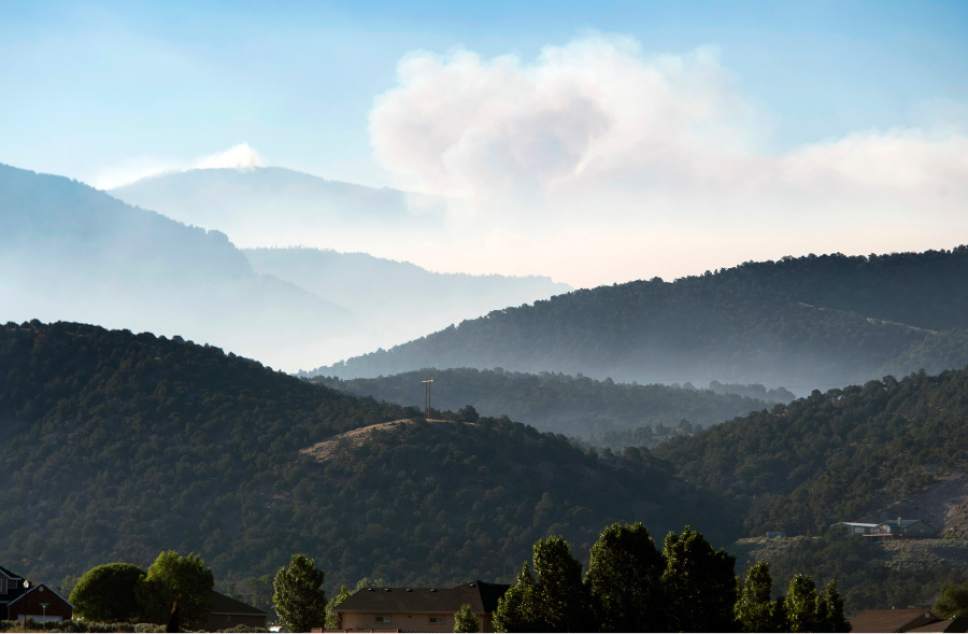This is an archived article that was published on sltrib.com in 2017, and information in the article may be outdated. It is provided only for personal research purposes and may not be reprinted.
Sizzling hot, windy weather had crews sweltering and scrambling Monday as they tried to capitalize on hard-won weekend progress against southern Utah's still-out-of-control Brian Head Fire.
More than 1,400 firefighters opened a second week of battle against the human-caused blaze near the Iron County ski resort, which at 46,000 acres remained the largest active wildfire in the nation. Crews estimated 10 percent containment; the fire is not expected to be fully hemmed in until July 15.
As of Monday, the 10th day of the fire, 21 buildings — 13 of them residences — had been destroyed, but efforts to prevent further structural losses were paying off.
Sunday "went very well due to the relatively calm weather conditions," said fire information officer Elayn Briggs, but she warned that "erratic winds" out of the southwest could propel flames along the northeastern flank. By Monday afternoon, this proved true, according to Jesse Bender, with the Type 2 Incident Management Team.
The firefighting army that attacked the blaze Monday included nearly 40 ground crews, almost 70 engines, two air tankers and 13 helicopters. The total personnel dedicated to the Brian Head Fire was up to 1,427 by nightfall, a news release from fire officials said.
Lt. Gov. Spencer Cox said the tab for fighting the flames was approaching $10 million and could reach $20 million, which could make it one of the most expensive fires in the state. He added that Utah would share that cost with the Forest Service and Bureau of Land Management.
The fire was believed to have been sparked about noon June 17 by an unidentified person torching weeds at Brian Head. No charges have been filed.
At a Monday news conference, southern Utah politicians blamed the fire's exponential growth on bark beetles and "tree-hugger" environmentalist groups who, they say, prevented the state from logging trees killed by bark beetles. The groups responded that climate change, excluding fire from the landscape and other factors are culprits for the destructive blaze.
Temperatures in the mid- to upper-90s Monday, along with 20 mph to 25 mph winds, gusting to 40 mph, stoked fears that flames could leap beyond existing, still incomplete, lines. In a worst-case scenario, Brian Head's northern flank was wide open to a potential two- to three-mile spread, fire managers warned.
Firefighters worked with shovels, chain saws and axes beside bulldozers to cut fire lines around the perimeter of the blaze. From above, water-bearing helicopters and retardant-laden air tankers targeted flare-ups and hot spots.
A prime focus of Monday's campaign was the fire's southern perimeter, where gusts fanned flames closer to the Mammoth Creek and Horse Valley areas.
The National Weather Service put much of southwest and south-central Utah under a "red flag" wildfire danger warning through 10 p.m. Monday.
An estimated 1,500 residents in the Brian Head area — including neighboring Upper Bear Valley, Panguitch Lake, Horse Valley, Beaver Dam, Castle Valley, Blue Springs, Rainbow Meadows, Mammoth Creek, Dry Lakes and Second Left Hand Canyon — have been evacuated over the past week and a half.
A couple of hundred firefighters and their vehicles have been stationed in the town of Brian Head, "combing through" it and extinguishing spot fires that ignited after embers from the wildfire blew into the area, Bender said.
Fire officials are "constantly gauging everyone's comfort level for letting residents back in," Bender said, but want to be sure the area is "completely safe" before that happens.
On Monday, as conditions permitted, residents reportedly were being allowed to quickly check their properties and retrieve need items.
The American Red Cross continued Monday to provide shelter and aid to evacuees at Panguitch High School. Another food, clothing and services delivery site was helping evacuees in nearby Parowan, said spokesman Pat Malan.
Southern Utah University spokeswoman Ellen Treanor said the school has been working with the Red Cross, offering six 10-bed apartment-style units temporarily for displaced families. At least one family had moved in last week, and more were scheduled to come this week, Treanor said.
The university wants to "help whoever needs help" and be a "good neighbor," she said.
Treanor added that organizers are also working with animal control services to provide a place for pets to stay while families are in the dorms. Families can visit the animals at the nearby shelter and take them for walks throughout the day, she said.
Highway 143 remained closed from the cemetery in Parowan to milepost 50 outside of Panguitch. Mammoth Creek Road was closed at the junction with Highway 143, and the north-side gate of 143/148 remained closed.
The Dixie National Forest also had expanded its area closure to include forest lands north of Highway 14.
Tuesday, fire officials expected firefighters would work off the constructed dozerline along the southern flank of the fire to clean up remaining hotspots and strengthen the containment line. They also plan to focus on securing and moping up hot spots that remain around structures in the Panguitch Lake area.
Twitter: @remims
— Reporter Mariah Noble contributed to this story Lt. Gov, state reps touring fire scene •
Lt. Gov. Spencer Cox and other state officials and lawmakers planned a Monday afternoon fact-finding visit to the Brian Head Fire area.
The team planned to meet 1 p.m. at the Giant Steps Lodge at Brian Head Resort. A news conference was planned to discuss the state's current wildfire situation.
Due to emergency fire operations in the area, media attending the availability were advised to drive from Cedar City to Brian Head, not through Parowan to Brian Head.
Reporters will be escorted to the resort once they reach the junction of highways 148 and 143.
— Utah Governor's Office







